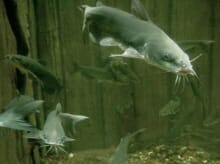 |
| Catfish Photo: stock.xchng |
With modern technology it has become easier to move different species into areas that are not their own their own eco-systems, but until a study by an international team, the measure of the human influence involved in establishing a non-native species into a new environment had not been fully recognised.
The study by scientists at the University Paul Sabatier of Toulouse, the Institut de Reserche pour le Dévelopment in Paris and the CNRS was the first global investigation of the processes involved in populating river basins with freshwater fish. The research was conducted in conjunction with scientists from the Groupe de recherche sur la gestion des écosystèmes of Antwerp University (Belgium) and the Centre Interniversitaire de Recherche sur le Saumon atlantique (CIRSA) of Laval University (Canada).
The investigation was conducted over 1,000 rivers with more than 10,000 freshwater fish species. It showed that the populations were largely down to human interference.
The study showed that the most river systems in the Northern hemisphere have been affected by humans and it warns that the river systems in developing countries, because of their richness and diversity are potentially at risk of the same fate, without vigilance.
The report shows that the particular environments are not always adapted for hosting new arrivals.
Past introduction attempts, such as that of wild rabbit into Australia or brown fario trout into Southern hemisphere water courses, led to awareness that these different species, qualified by scientists as non-native, have the power to upset an ecosystem.
Destruction of Natural Habitats
The 2002 Convention on Biodiversity recognised that the species introductions can cause regression of biological diversity, following destruction of natural habitats.
The examination of the data on presence of around 10,000 freshwater fish in 1055 river basins covering both 80 per cent immersed lands and 80 per cent of globally recorded freshwater fish species allowed identification of seven species-invasion hot-spots: the Pacific coast of North America and Central America, Patagonia, southern and western Europe, South Africa and Madagascar, central Asia, the South of Australia and New Zealand.
The research shows that these regions are characterised by river basins, where non-native species make up more than one quarter of the freshwater fish species recorded.
Moreover, the researchers say they are superimposed on biodiversity hot-spots, which correspond to geographical zones a strong endemism rate and a very high total number of species
The team also sought to determine the extent of the relative influence of the particular characteristics of each ecosystem and human activities on the diversity of the non-native fish species.
Three Hypotheses
Three hypotheses were tested: the "biotic resistance", "biotic acceptance" and "human activity".
The first suggests that a high diversity of freshwater fish in the host ecosystem acts as a barrier to the establishment of non-native fish specie populations. The second postulates conversely that, for a given ecosystem, non-native species diversity follows that of native species because favourable ecological conditions for the latter are also suitable for the newly arrived species.
As for the third, it takes account of the different indicators at river-basin scale (gross domestic product, percentage of land that had been urbanised, population density), that can yield determination of the relation between anthropic pressure and non-native species diversity.
The relative weight of these three hypotheses was measured using statistical methods.
For the whole set of river basins investigated, the environmental conditions of fluvial ecosystems were found to have practically no influence on the exotic species diversity.
On the contrary, the researchers said it is the human factors, and especially the intensity of economic activities -measured by the GDP, which determine the number of non-native species present in a river basin.
These results thus suggest that the economic development foreseen in the developing countries should be accompanied by a rise in the number of non-native freshwater fish species. Given that biological invasions are considered as one of the main causes of biodiversity loss, such a scenario would probably be detrimental to the aquatic biodiversity conservation of these regions.
The study indicates that exceptional river ecosystems, like the Amazon Basin in South America or that of the Congo in central Africa, are still hardly affected by species introduction. For example, no more than one per cent of the 3,000 species of fish recorded in the River Amazon are non-native species. Just as a considerable number of countries of the South are seeing their economic growth take off, this kind of study should be useful in the future for setting up an effective watch system for the surveillance of the exotic species colonising the most biodiversity-rich natural environments and make it possible to apply the principle of precaution before they become invasive.

